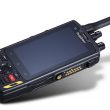Radio boosts readiness
Anchorage International Airport performed a rescue exercise this year-as it must, once every three years, to retain its operations certification with the FAA.
What made this year’s exercise different compared previous exercises was the sheer size of the play, the number of agencies involved and level of complexity.
The previous exercise of this type revealed several areas for improvement.
The addition of new participants and a new trunked radio system has made a tremendous difference.
Background
Anchorage is a leading cargo operations airport for the nation, handling far more traffic than the size of the city would normally indicate.
The location itself complicates rescue work. At the end of the major north-south runway is Cook Inlet, a body of water at a frigid temperature that can quickly kill accident victims.
Not long ago, a helicopter crew died when their craft fell into the inlet, a tragic reminder of the dangers of flying in Alaska.
A near miss this winter with a foreign cargo jet pointed to the need for an open water drill with all of the local public safety agencies involved.
Cook Inlet has fast (up to 6 kts), wide-ranging tides (38+ feet); murky, cold water; and heavy ice in winter. Its location straddles multiple jurisdictions.
The Anchorage fire department, the airport, the Alaska Air National Guard, the U.S. Army Aviation and the U.S. Coast Guard all have worked rescue efforts in the inlet over the years.
Recognizing its responsibility and the unforgiving environment for rescue operations, the airport management invited the major agencies to play in this required exercise.
The helicopter crash had shown the need to ensure that all local agencies could communicate and move quickly.
The exercise also offered a chance to bring diverse rescue elements together.
For example, the airport has acquired two-seat, high-speed hovercraft for operation in the inlet.
Designed to rapidly place rafts at the scene of a crash, they provide an immediate scouting ability when weather is marginal for low-level helicopter operations.
Moreover, ice pack is less of a factor in rescue operations with the hovercraft, another good reason to include them in the exercise and test possible hovercraft deployment strategies.
A new style of heli-borne rescue basket also had arrived in Anchorage, and the exercise represented a chance for rescue crews to practice removing multiple victims in a single pass.
Finally, a fire training simulator (actually a large commercial airframe with engines removed) for ground firefighting operations had shortly before been put into place. It was added to the mix to test land, sea and air coordination.
Using a simulated midair collision off the end of the main runway, the exercise was intended to force the air traffic control, airport operations and emergency operations center staff at the airport to call out and communicate with an almost bewildering array of land, sea and air rescue craft.
In addition to airboats; high-speed, two-man hovercraft and rescue boats; helicopters from the U.S. Coast Guard, U.S. Air Force, Alaska State Troopers and local air operator “ERA Helicopters” participated.
Victim transport and tracking also were tested.
Radio communications
The radio equipment used by agencies in the exercise operated on the VHF and UHF air bands, the VHF marine band, VHF and UHF land mobile radio bands and on a new trunked radio system.
Workers in the EOC had their hands full coordinating the activity safely. Fixed, mobile and hand-held equipment was used.
About the only thing missing for the exercise was a direct satellite link, but a link of that type was put in place later as part of a follow-on “weapons of mass destruction” reaction demonstration.
“Victims” from both the water and land “crash sites” were transported to multiple hospitals. Interestingly, amateur radio operators handled hospital intercommunications, victim dispatch and tracking-no doubt a continuing legacy of the 1964 Alaskan earthquake. Communications with ambulances, large city busses and other patient transports was worked with amateur radio operators riding along to tell drivers when and where to pick up the next set of passengers.
Although this was a fairly low-tech approach, it worked well, exercise planners said.
At the end of the day, Anchorage International had shown once more they had the ‘right stuff’ to handle even a major catastrophe.
They also had made the point interoperability was no longer an option in post-Sept. 11, 2001, America.
Civil, military and state aircraft were able to communicate and coordinate with sea and land based rescue personnel, showing the long hours of planning have paid off.
In the near future several more major exercises with city and local military teams are scheduled, and those results should prove to be equally interesting.












